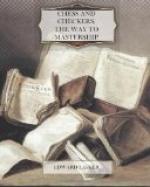(25)
... Q-g5+
(26)
K-h1 Rf8-d8
(27)
Q-e1
With the intention to play Q-e6+, thereby gaining time to swing over the Queen’s Rook to the King’s wing.
(27)
... K-h7
(28)
Q-c1
+---------------------------------------+ 8 | | | | #R | | | | | |---------------------------------------| 7 | | | | | | | #P | #K | |---------------------------------------| 6 | #P | | | | | | | #P | |---------------------------------------| 5 | | #P | | | | #P | #Q | | |---------------------------------------| 4 | | | | | | | | | |---------------------------------------| 3 | | ^P | ^P | | | ^P | | | |---------------------------------------| 2 | | ^P | | #R | | ^P | | ^R | |---------------------------------------| 1 | ^R | | ^Q | | | | | ^K | +---------------------------------------+ a b c d e f g h
Diagram 69.
The Queen cannot leave the first rank on account of the threat R-d1+. It lies near for Black to try to force her out by attacking the square d1 once more with the Queen, thereby threatening to win the Queen for a Rook by the check on d1. He can accomplish this by playing the Queen into the d-file behind the Rooks.
(28) ... R-d6
(29) P-c4
Apparently White does not recognize Black’s intention, or he would have played (29) Q-f1 in order to answer Q-d8 with (30) R-e1, R-dl; (31) K-g2. But Black would then also have had an easy win by playing (29) ..., Rxb2 and doubling the Rooks in the second rank.
(29)
... Q-d8
(30)
Q-c3
The only alternative to save the Queen was K-g2, but then R-d1 would have won a clear Rook.
Black now enforces a mate in ten moves: R-d1+; (31) Rxd1, Rxd1+; (32) K-g2, Q-g5+; (33) K-h3, R-g1; (34) Q-d4, Q-h5+; (35) Q-h4, Qxf3+; (36) Q-g3, Rxg3+; (37) Pxg3, P-f4; (38) K-h4, Qxg3+; (39) K-h5, Q-g5 mate. This instructive game was not lost through a faulty combination but on account of loss of time in the opening which could not be regained.
GAME NO. 2
Played in the New York Masters’ Tournament 1915
White Black Edward Lasker Jose Raoul Capablanca
(1) P-d4 P-d5 (2) Kt-f3 Kt-f6 (3) P-c4 P-e6 (4) Kt-c3 Ktb8-d7 (5) B-g5 B-b4
Ordinarily the Bishop is developed to e7 as on b4 he is out of place as soon as White has castled.
(6) P-e3 P-c5
With this move Black threatens Q-a5, attacking the Knight c3 for the second time and unpinning the Knight f6 who is then free to cooperate with the Bishop b4 and the Queen by advancing to e4. In trying to counter Black’s threat White will seek to do as much as he can for the development of his pieces so as to combine the attack with defense. The King’s Bishop is not yet developed, and his most natural developing move happens to cover the square at which Black is aiming with his Knight.




